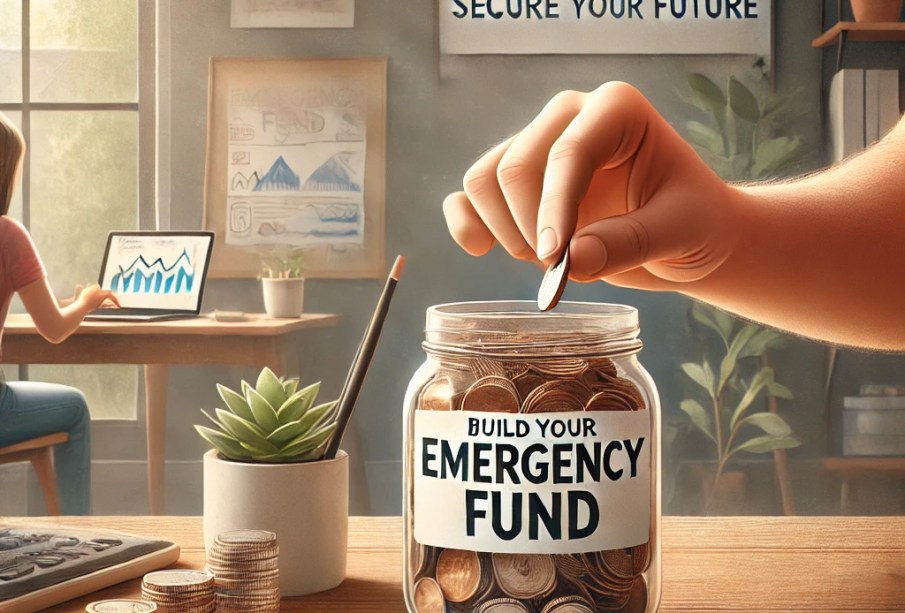How to Build an Emergency Fund: A Step-by-Step Guide

An emergency fund is one of the most important financial safety nets you can create. Life is unpredictable, and having money set aside for unexpected expenses—such as medical bills, car repairs, or job loss—can provide peace of mind and protect you from falling into debt.
In this blog, we’ll explore what an emergency fund is, why it’s essential, and how you can start building one, even on a tight budget.
What Is an Emergency Fund?
An emergency fund is a savings account specifically set aside for unplanned financial emergencies. Unlike other savings goals, this fund isn’t meant for planned expenses like holidays or new purchases—it’s reserved for genuine financial crises.
Why Is an Emergency Fund Important?
- Avoid Debt
With an emergency fund, you won’t need to rely on credit cards, payday loans, or borrowing from friends and family to cover unexpected expenses. - Peace of Mind
Knowing you have a safety net reduces financial stress and helps you focus on solving problems rather than worrying about money. - Financial Stability
An emergency fund keeps your finances on track, ensuring you don’t have to disrupt your long-term goals to deal with short-term setbacks.
How Much Should You Save?
The ideal size of an emergency fund depends on your financial situation and lifestyle.
- Starting Goal: Aim for £500–£1,000 to cover small emergencies.
- Long-Term Goal: Build three to six months’ worth of living expenses to cover larger disruptions, such as job loss.
Steps to Build an Emergency Fund
1. Set a Savings Goal
Determine how much you need for your emergency fund. Start with a realistic short-term target and work towards a larger goal over time.
2. Open a Separate Savings Account
Keep your emergency fund separate from your regular spending accounts to avoid dipping into it unnecessarily. Look for accounts with no fees and easy access when needed.
3. Start Small
If you’re on a tight budget, begin with small, regular contributions. Even saving £10 a week adds up over time.
4. Cut Unnecessary Expenses
Identify non-essential spending you can reduce or eliminate, such as eating out, subscriptions, or impulse purchases, and redirect that money into your emergency fund.
5. Automate Your Savings
Set up a standing order or automatic transfer to move money into your emergency fund each month. This ensures consistent progress without needing to think about it.
6. Use Windfalls Wisely
Redirect unexpected money, such as tax refunds, bonuses, or gifts, into your emergency fund to give it a boost.
7. Sell Unused Items
Declutter your home and sell items you no longer need. Use the proceeds to grow your emergency fund.
Where to Keep Your Emergency Fund
- Easy-Access Savings Account: Ensure your money is easily accessible in emergencies.
- High-Interest Savings Account: Earn interest on your savings while keeping your funds secure.
- Cash ISA: In the UK, a Cash ISA can be a tax-efficient option for your emergency fund.
Avoid risky investments for your emergency fund, as the primary goal is accessibility and security, not growth.
When to Use Your Emergency Fund
Use your emergency fund only for genuine, unexpected expenses, such as:
- Urgent car or home repairs.
- Medical bills not covered by insurance.
- Unexpected job loss or income reduction.
- Essential travel for family emergencies.
If you use your emergency fund, prioritize replenishing it as soon as possible.
Rebuilding Your Emergency Fund
After using your emergency fund, focus on rebuilding it to ensure you’re prepared for future emergencies:
- Review Your Budget: Identify areas where you can redirect funds to replenish your savings.
- Pause Non-Essential Spending: Temporarily halt discretionary expenses until your fund is restored.
- Set a New Target: Break your goal into smaller, achievable milestones.
Final Thoughts
Building an emergency fund is a critical step toward financial stability. It takes time and discipline, but the peace of mind and security it provides are worth the effort. Whether you’re starting with small savings or working towards a larger goal, the key is consistency and commitment.
At Debt Despair, we’re here to provide advice and resources to help you navigate your financial journey. Explore our blog for more tips on budgeting, saving, and achieving financial stability.
Start your emergency fund today and take control of your financial future.



















There’s a few good ideas here however people budgets just don’t allow for any form of saving
Thank you for your comment. We understand that for many people, managing a tight budget can make saving feel like an impossible task. However, even small steps can make a big difference over time. For instance, setting aside just a few pounds each week can gradually build up an emergency fund. We aim to provide tips that are practical and adaptable to a variety of financial situations, and we’re always open to hearing suggestions that could make our advice even more relevant to our readers.
Thank you again for sharing your thoughts!